Latest posts by (see all)
- The Best Things to Do in Tulsa - June 26, 2020
- The Most Interesting Things to Do in Springfield Mo - June 15, 2020
- Best Things to Do in Salt Lake City - May 26, 2020
- 10 Best Websites for Playing Online Games - May 22, 2020
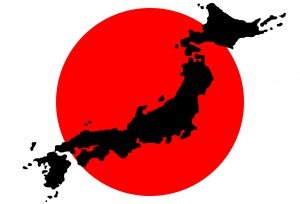 Amazing Japan, ancient and ultra-technocratic at the same time attracts hundreds of thousands of tourists every year. This is not surprising: where else can one climb the snow-capped peaks during one trip, take a dip in the warm sea, walk along the busy ancient streets, and then climb to the dizzying skyscrapers?
Amazing Japan, ancient and ultra-technocratic at the same time attracts hundreds of thousands of tourists every year. This is not surprising: where else can one climb the snow-capped peaks during one trip, take a dip in the warm sea, walk along the busy ancient streets, and then climb to the dizzying skyscrapers?
Japan’s attractions are so diverse that everyone will find something in the Land of the Rising Sun and take away only the best memories.
Contents
- Place to visit number 1: Tokyo Sky Tree
- Place to visit number 2: Mountain Fuji
- Place to visit number 3: The Castle of the White Heron
- Place to visit number 4: Matsumoto
- Place to visit number 5: The Imperial Palace
- Place to visit number 6: Kabuki-Za Theater
- Place to visit number 7: Toyota Mega Web
- Place to visit number 8: Disneyland in Tokyo
- Place to visit number 9: The Ghibli Museum
- Place to visit number 10: The Little Prince’s Museum
- Video
Place to visit number 1: Tokyo Sky Tree
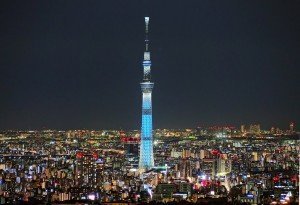 The capital of Japan, Tokyo, is not only beautiful castles, ancient temples, bubbling areas. One of the main symbols of the capital is the famous Tokyo television tower, outwardly similar to the tower of the Eiffel. Such a comparison is already flattering by itself and the view that opens from the viewing platform is simply fascinating. From here you can see the spectacular panorama of Tokyo and even the snow-capped peaks of the Fuji Mountains during the day and at night contemplate the sea of lights of the night city.
The capital of Japan, Tokyo, is not only beautiful castles, ancient temples, bubbling areas. One of the main symbols of the capital is the famous Tokyo television tower, outwardly similar to the tower of the Eiffel. Such a comparison is already flattering by itself and the view that opens from the viewing platform is simply fascinating. From here you can see the spectacular panorama of Tokyo and even the snow-capped peaks of the Fuji Mountains during the day and at night contemplate the sea of lights of the night city.
Tokyo Sky Tree is the highest in the world (634 meters) TV tower in the Tokyo area of Sumida, which was built to replace the old Tokyo television tower, which is almost half the size of the new one. Tokyo Sky Tower received its name as a result of the competition held in April-May 2008. As a result, it was his winners who first climbed to the tower observation platforms on May 22, 2012.
The construction itself continued for 3 and a half years – from July 2008 to February 29, 2012. The design was approved in 2006, the developer was the architectural firm Nikken Sekkei. The roof of the tower is at an altitude of 470 meters, followed by a huge antenna.
Observation platforms are at an altitude of 350 and 450 meters:
- The first (Tembo deck) can simultaneously accommodate up to 2,000 people,
- the second (Tembo galleria) – about 900.
Interesting: Its distinctive feature is a cheerful bright orange color in which it is painted. This color has been chosen not for aesthetic reasons but for the sake of aviation security. The Japanese managed to raise the tower that is higher than the one in Paris.
Back
Place to visit number 2: Mountain Fuji
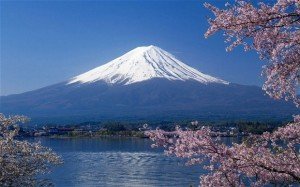 Mount Fuji or as it is also called Fujiyama is one of the most important Japanese sights. Not only tourists but also locals are dreaming of climbing it. The fact is that in Japan Mount Fuji is considered sacred and every resident of the country is simply obliged at least once in a lifetime to stand on its peak. Most travelers travel to this landmark in July and August – in these months Mount Fuji is free of snow.
Mount Fuji or as it is also called Fujiyama is one of the most important Japanese sights. Not only tourists but also locals are dreaming of climbing it. The fact is that in Japan Mount Fuji is considered sacred and every resident of the country is simply obliged at least once in a lifetime to stand on its peak. Most travelers travel to this landmark in July and August – in these months Mount Fuji is free of snow.
In this peak of the tourist season all amenities for guests of the country and local pilgrims are here provided:
- shops,
- small cafes,
- rescue centers,
- places for recreation.
Fujiyama is an active volcano located on the island of Honshu in the Fuji-Hakone-Izu National Park. To date, the volcano almost does not work. The last eruption was recorded in 1707-1708. It is worth noting that this was one of the most powerful eruptions during the entire existence of Mount Fuji.
Many of you probably saw the image of Mount Fuji in Japanese art. Almost in all engravings, the volcano is depicted with sharp inaccessible peaks and in snows. However, in reality it is not so difficult to climb the mountain and snow is not always there.
Interesting: Women were allowed to climb the mountain in 1800, before that time only men had such a right.
Back
Place to visit number 3: The Castle of the White Heron
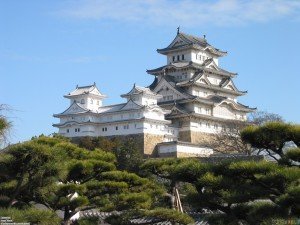 Himeji or the Castle of the White Heron was founded in 1333 and since then up to the 17th century experienced constant renovations, which were carried out in it by owners changing with an enviable frequency. This is one of the most ancient and colorful attractions of Japan, which in many respects influenced the character of the architecture of this country.
Himeji or the Castle of the White Heron was founded in 1333 and since then up to the 17th century experienced constant renovations, which were carried out in it by owners changing with an enviable frequency. This is one of the most ancient and colorful attractions of Japan, which in many respects influenced the character of the architecture of this country.
This castle is elegant and majestic at the same time, it is the best example of the fact that a flawless building from the standpoint of defense can also have perfect architectural forms. It is not surprising that in 1993 it was included in the UNESCO World Heritage List.
Why does this place attract tourists’ attention?
- The Castle of White Heron is so originally designed and elegant in its architecture that a less poetic name would be not suitable.
- There are particularly striking defensive walls with bizarre bends in the corners, which gives them a resemblance to a giant fan. They were built in a rather unusual way – they simply stones were piled up and in the corners they were fastened with already sharpened stone slabs.
- On the roof there is an unusual fish – it’s a magical amulet that protects the castle of the White Heron from the fire.
Over time, loopholes appeared here, various in shape and size, embrasures, towers, the main one of which is a temple, as well as a beautiful labyrinth garden. In total there are eighty-three buildings and most of them are wooden. The garden arose much later, it was conceived as a kind of defensive trick on the approaches to the castle – the attacking side had to be confused for a long time in the dead-ends of the labyrinths and the hosts in the meantime to lead them by firing from the towers. Climbing the steep stone staircase to the top of the main castle tower, in the upper, seventh tier of which is the temple of Osakabe Shinto, you can admire the mesmerizing view of the castle of Himeji and the town of the same name that originated at its foot several centuries ago.
Interesting: It is noteworthy that this city was completely destroyed by air strikes during the Second World War, but the castle remained unharmed.
Back
Place to visit number 4: Matsumoto
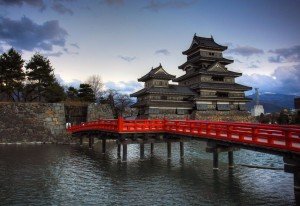 The ancient Matsumoto is located just 3 hours from Tokyo. Thanks to its location it gained fame as one of the most popular castles among tourists. It’s understandable: after watching the modern and largely dizzying sights of the country’s capital, all travelers are eager to look at Japan archaic:
The ancient Matsumoto is located just 3 hours from Tokyo. Thanks to its location it gained fame as one of the most popular castles among tourists. It’s understandable: after watching the modern and largely dizzying sights of the country’s capital, all travelers are eager to look at Japan archaic:
- with samurais,
- natural beauties,
- romantic legends.
All this can be found in Matsumoto. By analogy with the legendary White Heron Castle, Matsumoto was nicknamed “The Raven Castle” for the black color of the walls and the “wings” of the side towers. Another lyrical title went as far as the whole side of the citadel – it was intended for contemplation of the moon, that’s why it was called: “moon quarters”.
Not only history of the castle is interesting but also its architecture is very attractive. For example, Matsumoto is in the swampy terrain and not on a high hill or bank of a fast river like almost all other ancient castles in Japan. Another unique feature of this complex is three secret passages (while the rest of the country’s stronghold could boast of only one). Finally – the secret floor. If you look at Matsumoto from the outside, you can count only five floors and in fact six – closed by defensive plates without windows and natural light sources, this secret floor was intended for storing ammunition and food. In general, the owners of the castle carefully cared about their own safety so the fortress has been surrounded for a long time by a triple moat and high external stone walls, which stretched for 3 km – the distance of the cannon shot of that time.
Built in 1580 by the Ishikawa clan, the castle repeatedly suffered sieges and fires. One of the last overtook by Matsumoto in the late 19th century. After it, the castle took a long time to rebuild and the restoration started only in 1969. The works lasted until 2007 so that by the jubilee of the castle this pearl of the medieval architecture of Japan could rejoice its visitors again.
Interesting: Today in Matsumoto there is a museum where a collection of firearms and swords is kept. On the top floor of the castle there is the samurai hall and around the citadel there is a ditch with huge colored carp, along which white and black swans swim.
Back
Place to visit number 5: The Imperial Palace
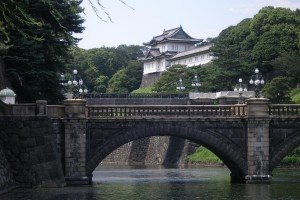 In the center of Tokyo in the thick green of trees, the palace of the emperor of Japan is surrounded by canals, moats and ancient walls. The entire palace complex is spread over an area of almost 7.5 square km. Access to it is limited but since 1968 its East Park is open to the public on certain days. The first Edo castle in this territory, built by a local ruler, appeared in the 15th century and from the beginning of 17 to the middle of 19 it belonged to the Tokugawa dynasty. After the deposition of the shogunate and the transfer of the capital from Kyoto to
In the center of Tokyo in the thick green of trees, the palace of the emperor of Japan is surrounded by canals, moats and ancient walls. The entire palace complex is spread over an area of almost 7.5 square km. Access to it is limited but since 1968 its East Park is open to the public on certain days. The first Edo castle in this territory, built by a local ruler, appeared in the 15th century and from the beginning of 17 to the middle of 19 it belonged to the Tokugawa dynasty. After the deposition of the shogunate and the transfer of the capital from Kyoto to
Tokyo, the castle becomes the permanent residence of the emperor, and in 1888 its reconstruction is completed in the Imperial Palace.
Because of the Japanese tradition, buildings were built of wood, they were often exposed to fires. So in the 19th century, the dominant of the castle complex burned, a 5-storey tower 51 meters high. The last fire after the bombing in World War II caused considerable damage to the numerous buildings of the palace.
The palace complex, rebuilt after the war, mostly retained the Japanese style but some buildings acquired the European look and were made of concrete.
Although today the emperor has a purely nominal power, he is still the most revered figure for the Japanese. The personal chambers of the emperor are strictly guarded and impenetrable for an outsider: under the territory where the palace complex is located, the laying of subway tunnels is forbidden, and in the sky above it – the flights of urban helicopters.
Only two times a year, on December 23 – the birthday of Emperor Akihito and January 2 – in honor of the New Year holiday, people are allowed to see their emperor, Empress Mitiko and the whole family, when they greet them standing in the square in front of the balcony of the palace, behind bulletproof windows.
An external East Park is open to the public, where you can enjoy the Japanese park art, the ancient walls of the Edo castle. For those wishing to go sightseeing there are excursions for an hour and a quarter in the courtyard of the complex without visiting the palace by appointment. The tour is accompanied by an audio guide in Japanese and English. The most wonderful time for visiting the park is March-April, when Sakura and plum are blooming.
The most popular places for filming are:
- the Nijubashi steel bridge,
- the Meganebashi stone bridge,
- the Fushimi Yagur watchtower, preserved since the time of the shogunate.
Interesting: In a building built in the middle of the last century with an exquisite name “Peach Garden Music Hall”, concerts of classical and traditional Japanese music are held.
Back
Place to visit number 6: Kabuki-Za Theater
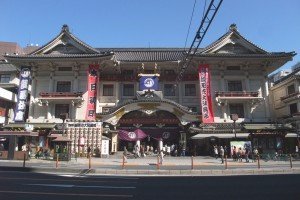 Kabuki-Za, located in the heart of Ginza, is the main Tokyo theater. It is not just one of the most unusual temples of Melpomene in the world, for the Japanese it is an object of national pride and reckless adoration. It’s hard to say what attracts an extremely clever nation: rich suits, crazy make-up, or the extremely florid semantic load but the fact remains that it is an idol and a God for the people who adore their culture and tradition. And so, going to Japan, you must certainly go there. Located in the repeatedly rebuilt and refurbished 1889 building, Kabuki-Za provides the best and most popular performances in the entire Japanese capital. The theater is designed for 1964 seats and on almost every show they are almost all occupied.
Kabuki-Za, located in the heart of Ginza, is the main Tokyo theater. It is not just one of the most unusual temples of Melpomene in the world, for the Japanese it is an object of national pride and reckless adoration. It’s hard to say what attracts an extremely clever nation: rich suits, crazy make-up, or the extremely florid semantic load but the fact remains that it is an idol and a God for the people who adore their culture and tradition. And so, going to Japan, you must certainly go there. Located in the repeatedly rebuilt and refurbished 1889 building, Kabuki-Za provides the best and most popular performances in the entire Japanese capital. The theater is designed for 1964 seats and on almost every show they are almost all occupied.
The word “kabuki” consists of three hieroglyphs, each of which in turn means:
- “singing”,
- “dancing”,
- “skill.”
Others decipher the name of the intricate theater as “breaking out of general rules” – and this is the best description of kabuki.
Interesting: For a long time, exclusively men could play there but today some women are allowed to play minor roles.
Back
Place to visit number 7: Toyota Mega Web
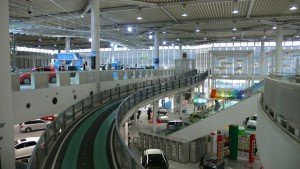 The main automobile museum of Japan, a fantastic amusement park and a showroom of Toyota concern in one are all Toyota Mega Web, a place where all fans of really cool cars should visit.
The main automobile museum of Japan, a fantastic amusement park and a showroom of Toyota concern in one are all Toyota Mega Web, a place where all fans of really cool cars should visit.
Want to see the cars of the future, more like rovers? Ride on ultra-modern high-speed cars? Make a photo against the background of an amazing, stylish, brilliant machine of the 1950-70s. Then you should go to the Toyota Mega Web! The automobile museum Toyota Mega Web includes six exhibitions, where hundreds of models of cars of the most different sizes, models and ages are presented. In particular, there are halls:
- History Garage,
- Universal Design Showcase,
- Toyota City Showcase,
- Ride One,
- Kids Hybrid Ride One.
The largest exhibition of the museum is the Toyota City Showcase, where you can get acquainted with all the existing and future models of Toyota. Nearby – Ride One that is the most popular hall of the Automobile Museum because it allows everyone with a driving license to drive the luxury wheelbarrow of the latest model. The trip, however, does not last long, only 1.3 km through three pavilions.
History Garage is for exquisite connoisseurs of antique cars, collected from around the world. In the hall of Universal Design Showcase you can get to know the process of car production and learn how modern machines make our life better.
Interesting: Located on several floors of the huge entertainment center Palette Town, this museum will provide an indescribable pleasure not only for motorists but for all adults and their kids.
Back
Place to visit number 8: Disneyland in Tokyo
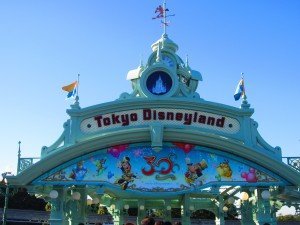 It was the first built outside the US. This amusement park is one of the main attractions of Japan located in Urayasu on the shores of Tokyo Bay and covers an area of about 47 hectares. The whole territory of the park is divided into 7 thematic zones, besides which there are also hotels, restaurants, shops, parking and other tourist infrastructure. Between the objects of the resort there is a monorail railway. There are several thematic zones:
It was the first built outside the US. This amusement park is one of the main attractions of Japan located in Urayasu on the shores of Tokyo Bay and covers an area of about 47 hectares. The whole territory of the park is divided into 7 thematic zones, besides which there are also hotels, restaurants, shops, parking and other tourist infrastructure. Between the objects of the resort there is a monorail railway. There are several thematic zones:
- “Country of Fantasies”: the Cinderella castle, the flights of Peter Pen, the flying elephant Dambo and other famous cartoons.
- “Country of Adventure”is divided into two zones: The first is a tropical jungle, and the second is an attraction about “Pirates of the Caribbean”.
- “City of Cartoons” is all the “celebrities” of the Disney World: Mickey Mouse with Minnie’s girlfriend, Chip and Dale, Donald Duck with nephews and many, many others.
- “Country of the Future” invites you to make a journey into space. There are many technological and futuristic attractions.
- “Country of the Wild West” is a world of cowboys with a real river and roller coaster, which is painted the same as the trains that really existed during the Wild West.
- “Land of the Beasts”, the smallest zone where you can ride in a boat.
- “World Bazaar” is where you can buy any souvenirs.
Interesting: Every evening at Disneyland there is a solemn procession of all the characters with music and fireworks shows.
Back
Place to visit number 9: The Ghibli Museum
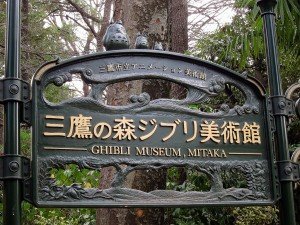 This is one of the largest animation studios, which was founded in 1985 by the legendary Hayao Miyazaki. It is perhaps the best that anime fans can find in Tokyo. In the days of Japanese school holidays, it is worth to think about getting tickets 2-3 weeks beforehand.
This is one of the largest animation studios, which was founded in 1985 by the legendary Hayao Miyazaki. It is perhaps the best that anime fans can find in Tokyo. In the days of Japanese school holidays, it is worth to think about getting tickets 2-3 weeks beforehand.
Ghibli studio gave the world a lot of animated masterpieces, including:
- “My Neighbor Totoro”,
- “Spirited Away”,
- “Princess Mononoke.”
Of course, in the first place the museum is designed for children, but all adults who are not indifferent to anime will also be satisfied. There are not many exhibits here, but full of touching details, for example, traces of outlandish animals in the corners, miniature statuettes of seals, sitting on the faucets in the toilet rooms, spiral staircases, labyrinths, secret passages, magic lanterns explaining the nature of the animation.
Interesting: Without the cartoons of this studio it is simply impossible to imagine modern Japan.
Back
Place to visit number 10: The Little Prince’s Museum
 The Japanese seem to be an amazing nation. Well, who else would have thought of creating in the territory of a small resort town, famous for its hot springs, a real corner of Provence? In Hakone, that’s exactly what they did: with the help of the television corporation Tokyo Broadcasting System Television in 1999, the Little Prince’s Museum was opened here.
The Japanese seem to be an amazing nation. Well, who else would have thought of creating in the territory of a small resort town, famous for its hot springs, a real corner of Provence? In Hakone, that’s exactly what they did: with the help of the television corporation Tokyo Broadcasting System Television in 1999, the Little Prince’s Museum was opened here.
The exposition tells about the life of the author of the famous literary character with the help of his original letters and photographs. Besides the museum, there are:
- a small French town,
- shops,
- famous bakeries,
- the theater designed in the form of a desert telling all visitors about the difficult fate of the Little Prince in Japanese.
Finally, it is worth to have a walk through the picturesque museum park – Japanese masters of the landscape designer managed to create an exposition on its territory that is good at any time of the year.
Interesting: It is a good idea to finish an amazing day in the company with the Little Prince in the French restaurant at the museum. In the menu you will find fresh organic vegetables and dishes from meat or fish.
I simply wanted to compose a brief note to express gratitude to you for all the remarkable techniques you are writing on this website. My extended internet lookup has finally been paid with useful knowledge to exchange with my family members. I ‘d state that that most of us website visitors are quite blessed to be in a good community with many wonderful people with helpful basics. I feel truly grateful to have discovered your website and look forward to tons of more excellent minutes reading here. Thanks again for all the details.